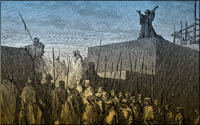 If not for legendary efforts of Ezra and Nehemiah the fledgling Jewish community in Israel would not have survived as we know it.
If not for legendary efforts of Ezra and Nehemiah the fledgling Jewish community in Israel would not have survived as we know it.
If history is people, the history of the Second Commonwealth begins with one of history’s greatest personalities: Ezra the Scribe, who was descended from the priestly family of Aaron. The Talmud says that if the Torah would not have been given through Moses it would have been given through Ezra (Sanhedrin 21b).
He arrived just in nick of time. The fledgling Jewish community in the Land of Israel was under siege and disintegrating. They were physically threatened. They were intermarrying. They were desecrating the Sabbath. They were assimilating. It sounds like headlines in this week’s newspaper, but it describes the situation 2,500 years ago at a major crossroads in Jewish history.
By the force of his great personality, Ezra was able reverse the terrible situation in a very short period of time.
Surveying the Scene
Ezra did not come with the original group of returnees who accompanied Zerubbabel when the decree by Cyrus was first announced that the Jews could return to their land and build their Temple (Ezra 1:1-3). As the primary disciple of Baruch the son of Neriah (who had been the primary disciple of Jeremiah), he remained by the side of his great teacher in Babylon until his passing, the Talmud says (Megillah 16b).
While in Babylon, Ezra organized a little over 40,000 Jews to return with him to the Land of Israel. Out of a population of perhaps a half million Jews that number was not very impressive. Worse, he could not conscript the caliber of Jews he wanted. The greatest Torah scholars and the Levites stayed behind.
When Ezra did arrive in the Land of Israel, he saw a Jewish community that had broken down spiritually. Some traditional sources that suggest the intermarriage rate was as high as 85-90%. The situation was so bad that the High Priest — whom all the Jewish people looked to for spiritual leadership — had sons who married non-Jewish women.
Ezra also saw that all the Jewish-owned stores in Jerusalem were open on the Sabbath, which was the market day. The non-Jews from the neighboring towns and villages would come into Jerusalem on the Sabbath to make purchases. The Jewish shop-owners told Ezra that they had found legal loopholes in Jewish law for doing so.
It was like Moses coming down from Mount Sinai with the Tablets of the Ten Commandments in his hand and seeing the Golden Calf.
Ezra also had to deal with the political problem. They were not allowed to build the Temple and the Samaritans dominated the scene – threatening with violence anyone who would oppose them.
Nehemiah
Enter the second man to turn the situation around: Nehemiah.
He was a prominent Jew who rose to very high office under the Persian emperor Darius. Hearing about the situation, he approached the king with a very brazen proposition. He asked to be allowed to take a leave of absence to help his brethren get settled and build the Temple. Then he would return.
In the ancient world, if the king did not like an idea like that you were a head shorter. It smacked of dual loyalties. Why should his most trusted advisor be worried about Jerusalem when he was working for him in the palace? Nehemiah took a great risk asking it.
Fortunately, the king agreed. Not only that, but he gave him an army contingent and carte blanche to use them as he saw fit.
When Ezra came the Samaritans were not too nervous. Another rabbi, they thought. However, when Nehemiah came he came with the might of the Persian army behind him. He came equipped to do battle. And battle he did — physical battle and political battle.
Building the Wall
Although decades earlier the walls of Jerusalem had been breached by the Babylonians, in effect making the city indefensible, many parts of the wall still stood. Tactically, Nehemiah realized that the first task was to fill in the gaps and create one continuous wall (Nehemiah 2:17). He organized the work right away. Quickly, the downtrodden Jews joined together and completed the wall halfway, injecting them with a new sense of hope and courage (Nehemiah 3:38).
Their enemies at first looked on mockingly and doubted their ability to build any type of useful wall. However, as it actually began to spring up before their eyes their arrogance turned into panic and they schemed to disrupt the work (Nehemiah 4:1-5).
However, Nehemiah organized them into family units capable of defending themselves at the same time they continued the work of fixing the wall. Day after day, from dawn into the night, they worked: “We labored in the work… from the break of dawn till the stars appeared” (Nehemiah 4:15).
All their work paid off and, miraculously, they completed the job in a mere 52 days. Remember, this was without heavy equipment and under the constant threat of attack. It was truly a remarkable feat.
Thanks to Nehemiah, Jerusalem now had a physical wall to protect the Jewish people. Next it was up to Ezra to set up a spiritual wall.
Ezra’s Decrees
In order to be successful on any front the Jewish people had to be strengthened internally. One of the first measures took Ezra was to make an ultimatum forcing all Jewish men to divorce their non-Jewish wives or at least have the women convert. Whoever refused would be excluded from the community. For the matter of spiritual survival no compromises could be made.
Then he addressed the Sabbath desecration. The Jewish shop-owners had in many cases found legal loopholes to conduct their work on the Day of Rest. Ezra passed decrees closing the loopholes and forbidding work on the Sabbath.
Ultimately, Ezra and Nehemiah called a convention and administered what became known as, “The Covenant of Faith” (Nehemiah, Chapter 10). The people read from the Book of Deuteronomy, which describes all the laws and ideals they were not living up to. They all wept and repented, and agreed to uphold the Torah from then on, especially to observe the Sabbath, bring the tithes and donations to the Temple and refrain from intermarriage.
The Pocket
Within a short five year span, Ezra and Nehemiah together turned the situation around. Nevertheless, life for the start-up Jewish community remained precarious.
The Persian Empire was massive. It stretched from India in the east to the Sahara Desert (modern day Libya) in the west. In the north it reached to the Black Sea and the Greek Islands. It encompassed four continents: Asia Minor, the Middle East, parts of Africa and Southern Europe.
By contrast, the area controlled by the Jewish people at the time of Ezra and Nehemiah was not more than a 25 mile radius from Jerusalem. The rest of the country was occupied by the belligerent Samaritans, Phoenicians, Idumeans and other fierce peoples. In short, the Jews who resettled the land in the time of Ezra and Nehemiah lived in a small indefensible enclave around Jerusalem with no natural resources surrounded by enemies and in the shadow of an ambivalent giant that trusted and distrusted them, that granted them legitimacy but did not want them to become too legitimate, that embraced them but kept them at arm’s length.
The Second Temple
Ezra set about building the Second Temple, but lacked the funds to give it the physical magnificence of its predecessor. On the day it was dedicated those who remembered the First Temple wept (Ezra 3:12), because it was such a far cry from its predecessor. The First Temple was made of gold and other precious metals. Its stones were magnificent marble. The wooden parts were made from cedar and acacia, the strongest and best type of wood. It was one of the wonders of the ancient world.
The Second Temple, by comparison, was small and made entirely out of wood. They could not afford to make it out of stone. It was put together quickly. It was primitive. Consequently, those who saw it and remembered what the first one was like wept. They saw in one stark comparison how far they had fallen.
The Second Temple would be rebuilt no less than four times, but it would not be until the time of Herod several centuries later that it would regain its stature as one of the wonders of the world. On one hand, Ezra’s Temple was a source of consolation. On the other hand, it was a reminder to the people how far they had fallen and how far they had to go.
No More Prophecy
The Second Temple lacked spiritual magnificence as well. It was missing, for instance, the great golden menorah-candelabra that Moses had made. It had no Ark and no Tablets of the Ten Commandments.
Furthermore, there was no more prophecy in the Second Temple era, the Talmud says (Sotah 48b). We have to realize that for a people who were accustomed to prophecy it was a wrenching experience. Prophets not only predicted the future but interpreted current events… authoritatively.
In the Second Temple era there was also a retrenchment of the Divine Providence. God worked no longer through open miracles, but through natural means. It was as if He had withdrawn or hidden His Presence.
No matter how one looked at it the Second Temple era was physically and spiritually impoverished. That was the climate in the beginning of the story of the Second Commonwealth. That is why, as we will see, the turbulence and upheavals of the next few centuries are unmatched in the annals of Jewish history. Much of it is directly linked to the nearly impossible conditions under which the Second Commonwealth began. It will be an era of almost never-ending revolution, war and internal strife.
If the Jewish people could survive the Second Temple era they could survive anything.











